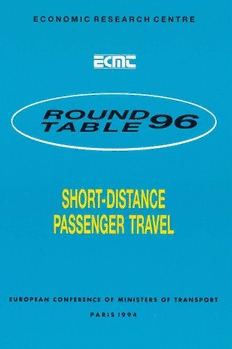
Short-distance Passenger Travel : Report of the Ninety-Sixth Round Table on Transport Economics Held in Paris on 10-11 June 1993 PDF
Preview Short-distance Passenger Travel : Report of the Ninety-Sixth Round Table on Transport Economics Held in Paris on 10-11 June 1993
ECONOMIC RESEARCH CENTRE EUROPEAN CONFERENCE OF MINISTERS OF TRANSPORT PARIS 1994 ECONOMIC RESEARCH CENTRE REPORT OF THE NINETY-SIXTH ROUND TABLE ON TRANSPORT ECONOMICS held in Paris on 10th-11th June 1993 on the following topic: SHORT-DISTANCE PASSENGER TRAVEL EUROPEAN CONFERENCE OF MINISTERS OF TRANSPORT THE EUROPEAN CONFERENCE OF MINISTERS OFTRANSPORT (ECMT) The European Conference of Ministers of Transport (ECMT) is an inter-governmental organisation established by a Protocol signed in Brussels on 17th October 1953. The Council ofthe Conferencecomprisesthe MinistersofTransportof31 Europeancountries.' TheworkoftheCouncil of MinistersispreparedbyaCommitteeofDeputies. ThepurposesoftheConferenceare: a) to take whatever measures may be necessary to achieve, at general or regional level, the most efficient use and rational development ofEuropean inland transport of international importance; b) to co-ordinate and promote the activities of international organisations concerned with European inlandtransport, taking intoaccount the workofsupranational authorities in this field. The mattersgenerally studied by ECMT- and on which the Ministerstake decisions - include: the general lines oftransport policy; investment in the sector; infrastructural needs; specific aspects of the development ofrail, road and inland waterways transport; combined transport issues; urban travel; road safety and traffic rules, signs and signals; access to transport for people with mobility problems. Othersubjectsnowbeingexaminedindepth are: the futureapplicationsofnewtechnologies,protection oftheenvironment,andtheintegrationoftheEastEuropeancountriesinthe Europeantransportmarket. Statistical analysesoftrendsintrafficandinvestmentarepublishedeachyear,thusthrowinglightonthe prevailingeconomicsituation. The ECMT organises Round Tables and Symposia. Their conclusions are considered by the competentorgansoftheConference,undertheauthorityofthe CommitteeofDeputies,sothatthe latter mayformulateproposalsforpolicydecisionstobesubmittedtotheMinisters. TheECMTDocumentation Centre maintainstheTRANSDOCdatabase, which can be accessed on-lineviathetelecommunicationsnetwork. For administrative purposes, the ECMT Secretariat is attached to the Secretariat of the OrganisationforEconomicCo-operationandDevelopment(OECD). 1. Austria,Belgium, Bosnia-Herzegovina,Bulgaria,Croatia, theCzech Republic, Denmark, Estonia, Finland, France, Germany,Greece,Hungary,Ireland,Italy,Latvia,Lithuania,Luxembourg,Moldova,theNetherlands,Norway,Poland,Portugal, Romania,the SlovakRepublic,Slovenia, Spain,Sweden,Switzerland,TurkeyandtheUnited Kingdom. (Associate Member countries:Australia,Canada,Japan,NewZealand,the RussianFederationandtheUnitedStates.Observercountries:Albania, Morocco.) Publieenfrancaissouslelitre: LESDEPLACEMENTSDEPERSONNES ACOURTEDISTANCE TABLERONDE96 ©ECMT, 1994 ECMTpublicationsaredistributedbytheOECDPublicationsService, 2,rueAndre-Pascal,75775PARISCEDEX16,France. Applicationforpermissiontoreproduceortranslateallorpart ofthispublicationshouldbemadeto: ECMT 2,rueAndre-Pascal,75775PARISCEDEX16,France. TABLE OF CONTENTS GERMANY BROG, W. and ERL, E(cid:9) 5 FRANCE BIEBER, A(cid:9) 69 SUMMARY OF DISCUSSIONS (Round Table debate on reports) (cid:9) Ill LIST OF PARTICIPANTS (cid:9) 125 GERMANY Werner BROG Erhard ERL SOCIALDATA Munich Germany THE IMPORTANCE OF NON-MOTORISED TRANSPORT FOR MOBILITY IN OUR CITIES SUMMARY 1. INTRODUCTION (cid:9) 9 2. MODAL CHOICE (cid:9) 10 2.1. Representation of modal choice (cid:9) 11 2.2. Estimation of modal choice (cid:9) 12 2.3. Spatial distribution (cid:9) 13 3. MOBILITY (cid:9) 13 3.1. Duration of travel (cid:9) 13 3.2. Activities (cid:9) 14 3.3. Distances (cid:9) 14 3.4. Trend over time (cid:9) 15 3.5. Car use (cid:9) 15 4. REPLACEMENT OF CAR TRIPS (cid:9) 16 4.1. Replaceability of car trips (cid:9) 16 4.2. Non-motorised transport modes as alternatives to the car ... 17 4.3. The potential for non-motorised transport (cid:9) 18 5. OPINIONS AND EXPECTATIONS (cid:9) 19 6. FURTHER CONSIDERATIONS (cid:9) (cid:9) 20 FIGURES (cid:9) 25 BIBLIOGRAPHY (cid:9) 67 Munich, January 1993 1. INTRODUCTION The beginning ofreconstruction after the Second World War meant, among other things, new bases and objectives for transport policy and planning. Attention was mainly directed at the promotion of motorised private transport, which was resolutely and systematically pursued, even where this led to disadvantages for the other transport modes. Non-motorised transport wasparticularly hard hit, mobility in many planning concepts being reduced to motorised mobility, even though the proportion of non-motorised mobility amounted to at least half of all trips until the early seventies. This led tojudgments and assessments ofmobility which, even though mistaken, became widely accepted guidelines for transport planning. This hitherto stable structure was shaken slightly for the first time at the beginning of the eighties with the rediscovery of the bicycle. Despite considerable efforts however it has still not been possible to make the bicycle generally recognised as an everyday mode of transport. When it finally became clear at the beginning of the nineties that the promotion of motorised private transport is simply not capable of resolving the associated problems itself, even the automobile industry, for example, admitted that transport planning based on a single mode just cannot work. However, since the earlier fixation of the mobility concept on motorised mobility was, forthe most part, not abandoned, the promotion ofpublic transport and its linking with motorised private transport was seen as the only measure that could improve transport conditions in our towns. This view was based on the earlier misjudgments on (motorised) mobility, which are still very prevalent. These misjudgments are largely responsible for the fact that the importance ofnon-motorisedtransportforaneffective, and acceptable, mobility systemin our towns continues to be underestimated.
